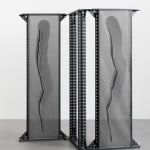-
Lou Jaworski
ZE, 2023Digital data storage racks and halftone grid print on stainless steel mesh194 x 175 x 80 cm
76 3/8 x 68 7/8 x 31 1/2 inchesCopyright The ArtistPhoto: Dirk TackeWeitere Abbildungen
-
(View a larger image of thumbnail 1
)

-
(View a larger image of thumbnail 2
)

-
(View a larger image of thumbnail 3
)

-
(View a larger image of thumbnail 4
)

-
(View a larger image of thumbnail 5
)

-
(View a larger image of thumbnail 6
)

-
(View a larger image of thumbnail 7
)

-
(View a larger image of thumbnail 8
)

(english and german below) La scultura „ZE“ è composta da due stampe a pigmenti UV su rete in acciaio inossidabile, che sono tese in una struttura architettonica realizzata con componenti...(english and german below)
La scultura „ZE“ è composta da due stampe a pigmenti UV su rete in acciaio inossidabile, che sono tese in una struttura architettonica realizzata con componenti di rack per server. Le stampe semi-trasparenti sono disposte in una griglia lineare e cambiano intensamente a seconda dell‘incidenza della luce, stimolando i meccanismi di percezione dell‘occhio.
Con il processo di stampa in mezzatinta, l‘effetto delle tonalità di colore e dei livelli di grigio delle immagini viene ottenuto utilizzando una disposizione ragionata delle linee di trama. Jaworski utilizza questo processo per creare un gradiente dallo scuro al chiaro e per tracciare il contorno di una forma cilindrica che sembra muoversi nello spazio dell’immagine come un ologramma in continua espansione. „ZE“ appare come un gioco digitale di luce e ombra, appena tangibile, tra un‘immagine piatta e una espansione nelle dimensioni spaziali. La struttura portante è composta da un sistema modulare che si apre come uno schermo nella stanza e i cui componenti provengono da grandi rack per server, progettati per immagazzinare dati pubblici e privati. In questa disposizione la scultura, realizzata con frammenti di hardware separati e riassemblati, ricorda un trittico, e affronta il tema della cancellazione e l‘occultamento dei dati su più livelli.
L‘opera di Jaworski diventa quindi un simbolo di un flusso di energia e informazione, e suggeri- sce un‘interazione tra frammenti tecnologici e contenuti visivi espandibili modularmente.
Die Skulptur „ZE“ besteht aus zwei UV-Pigmentdrucken auf Edelstahlgewebe, die in eine architektonische Struktur aus Serverrack-Komponenten eingespannt sind. Die semitransparenten Drucke sind in einem linienförmigen Raster angelegt und changieren je nach Lichteinfall intensiv und regen die Wahrnehmungsmechanismen des Auges an. Bei dem angewendeten Druckverfahren im Halbtonraster wird der Eindruck von Farbtonwerten und Graustufen von Bildern durch eine geeignete Anordnung von Rasterlinien erreicht. Jaworski nutzt dieses Verfahren um einen Verlauf von dunkel zu hell zu erzeugen und die Umrisse einer zylindrischen Form abzuzeichnen, die sich wie ein ständig erweiterndes Hologramm im Bildraum zu bewegen scheint. So wirkt „ZE“ wie ein digitales Spiel aus Licht und Schatten, kaum greifbar, zwischen flachem Bild und Erweiterung in räumliche Dimension. Die tragende Struktur setzt sich aus einem modularen System zusammen, dass sich wie ein Paravent im Raum entfaltet und deren Bestandteile von großen Serverracks kommen, die für die Speicherung öffentlicher und privater Daten genutzt wurden. In dieser Anordnung erinnert die Skulptur aus herausgelösten und neu zusammengesetzten Hardware-Fragmenten an ein aufklappbares Tafelbild und thematisiert auf mehreren Ebenen das Löschen und Verdecken von Daten.
Jaworskis Werk wird so zum Symbol für einen Energie- und Informationsfluss und deutet ein Wechselspiel aus technologischen Fragmenten und modular erweiterbaren Bildinhalten an.
The sculpture “ZE” consists of two UV pigment prints on stainless steel mesh, which are stretched into an architectural structure made of server rack components. The semi-transparent prints are laid out in a line-shaped grid and change intensively depending on the incidence of light and stimulate the eye's perception mechanisms. With the halftone printing process, the impression of color tones and gray levels of images is achieved by using a suitable arrangement of screen lines. Jaworski uses this process to create a gradient from dark to light and to trace the outline of a cylindrical shape that appears to move in the image space like an ever-expanding hologram. “ZE” appears like a digital game of light and shadow, barely tangible, between a flat image and an expansion in spatial dimensions. The supporting structure is composed of a modular system that unfolds like a screen in the room and whose components come from large server racks designed to store public and private data. In this arrangement, the sculpture made of detached and reassembled hardware fragments is reminiscent of a triptych and addresses the deletion and concealment of data on several levels.
Jaworski's work thus becomes a symbol of a flow of energy and information and suggests an interplay of technological fragments and modularly expandable image content. -
(View a larger image of thumbnail 1
)







